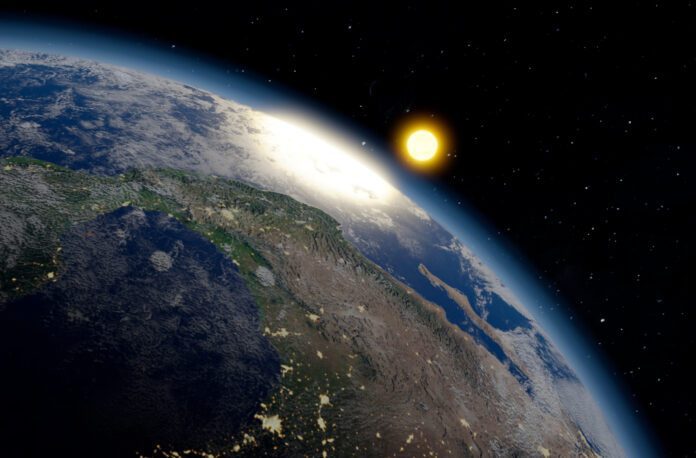Imagine floating weightlessly above the Earth, gazing down at the planet as a glowing blue marble in the vastness of space. For decades, this kind of experience was only a dream, reserved for a select few astronauts. However, with the rapid advancements in technology, space tourism is no longer a distant fantasy—it’s happening now, and it’s poised to become the next big adventure for everyday people.
In this post, we’re going to dive deep into the world of space tourism. From the early beginnings of space travel to the companies shaping its future, we’ll explore how space tourism works, what it’s like to take a trip to the edge of space, and what the future holds for those of us who dream of becoming space travelers. So, buckle up and get ready for a trip beyond the stars!
What is Space Tourism?
Space tourism is exactly what it sounds like: traveling to space for fun. This isn’t about astronauts heading off on scientific missions or exploring distant planets (though, we’ll talk about that possibility too); it’s about ordinary people—like you and me—taking a trip to space, purely for the thrill of it.
In the simplest terms, space tourism offers people the chance to experience space travel, whether it’s a short trip to the edge of space or something more ambitious like orbiting the Earth or, in the distant future, even visiting the Moon or Mars. It’s an industry that’s growing rapidly, with several big players making headlines for their efforts to bring space closer to home.
A Glimpse into the History of Space Tourism
Before we jump into what’s happening now, let’s take a step back and look at how we got here. The idea of space travel has always fascinated humanity. Since the dawn of the space age in the 1960s, the dream of sending regular people into space has been a popular theme in science fiction.
However, it wasn’t until 2001 that this dream became a reality when Dennis Tito, an American businessman, became the first space tourist. He paid a staggering $20 million to hitch a ride on a Russian Soyuz spacecraft to the International Space Station (ISS). Tito’s journey was groundbreaking and marked the beginning of civilian space travel. Even though the cost was out of reach for most people, it opened the door to what could eventually become a more affordable and accessible experience.
Fast forward to today, and we’re seeing incredible advancements in technology and innovation, pushing space tourism closer to becoming a mainstream option for adventurous travelers.
The Major Players in Space Tourism
1. SpaceX: Elon Musk’s Vision for the Stars
If you follow space news, you’ve probably heard of SpaceX. Founded by Elon Musk, SpaceX has been a game-changer in the world of space travel. Musk’s goal is ambitious: he wants to make space accessible not only for tourism but for exploration and even colonization. SpaceX’s reusable rocket technology has slashed the cost of space travel, making it much more feasible for companies and (eventually) individuals to head into space.
In 2021, SpaceX took a huge leap with Inspiration4, the first mission to send an all-civilian crew into orbit. This historic flight didn’t just take its passengers to the edge of space for a brief moment—it orbited the Earth for three days! That’s just a taste of what SpaceX has planned. In the near future, the company is planning trips around the Moon aboard its Starship spacecraft, with Mars firmly in Musk’s long-term vision for space tourism.
2. Blue Origin: Jeff Bezos’ Space Dream
Amazon founder Jeff Bezos is also heavily invested in the future of space tourism through his company Blue Origin. In 2021, Bezos made headlines when he personally took a ride to space aboard New Shepard, a rocket designed specifically for suborbital flights.
What’s suborbital, you ask? Unlike trips to the ISS or around the Earth, suborbital flights are much shorter. New Shepard takes passengers just beyond the Kármán line (about 100 kilometers above Earth), where they can experience a few minutes of weightlessness and incredible views of Earth before descending back to the ground. These trips last about 10-15 minutes in total, but they’re packed with excitement and a once-in-a-lifetime experience.
Bezos and Blue Origin aim to make these short spaceflights a regular occurrence, with tickets currently selling for around $450,000.
3. Virgin Galactic: Richard Branson’s Space Adventure
Not to be outdone, Virgin Galactic, founded by British entrepreneur Richard Branson, is also in the race to make space tourism a reality. Unlike SpaceX or Blue Origin, Virgin Galactic uses a unique air-launch system. Instead of a traditional rocket blasting off vertically, Virgin Galactic’s SpaceShipTwo is carried into the sky by a mothership. Once it reaches the right altitude, SpaceShipTwo detaches and fires its rocket engines, taking passengers to the edge of space.
In July 2021, Branson himself took part in a test flight, marking a major milestone for the company. Virgin Galactic offers suborbital flights, much like Blue Origin, but the experience is slightly different. The launch method and spacecraft design make the trip feel more like an extended airplane flight, with added thrills, of course.
Virgin Galactic is aiming to create a luxury space experience, with tickets priced similarly to Blue Origin at around $450,000. While these prices are steep, the company hopes that over time, costs will come down, making space tourism more affordable for more people.

The Space Tourism Experience: What to Expect
Now, let’s talk about what the experience is actually like for a space tourist. Depending on the company and the type of flight you choose, your trip to space could last anywhere from a few minutes to several days. But no matter how long you spend in space, one thing is for sure: it’s a life-changing experience.
Suborbital Flights: Short but Spectacular
Suborbital flights, like those offered by Blue Origin and Virgin Galactic, give passengers a quick but unforgettable taste of space. After the rocket (or spacecraft) takes off, you’ll ascend to the edge of space, reaching altitudes of over 100 kilometers. At this height, you’ll experience weightlessness for a few glorious minutes. You’ll be able to float around the cabin and look out at the breathtaking view of Earth, a sight very few people have seen firsthand.
This phenomenon is often called the Overview Effect, a powerful cognitive shift in perspective that astronauts often describe after seeing Earth from space. It’s the feeling of realizing just how small and interconnected we all are on this planet. Even though suborbital flights are relatively short, this feeling can stay with you for the rest of your life.
Orbital Flights: A True Space Adventure
If you’re looking for something a bit more adventurous, orbital flights may be what you’re after. Unlike suborbital trips, orbital flights take you around the Earth, allowing you to experience life in space for days at a time. SpaceX, with its Crew Dragon capsule, is the main player in this space (pun intended).
An orbital flight means you’ll spend time circling the Earth, experiencing multiple sunrises and sunsets every day. You’ll get to sleep, eat, and live in zero gravity, just like professional astronauts on the ISS. This type of trip is still in its early stages, but it’s expected to become more common in the coming years.
Future Dreams: Lunar and Mars Trips
While the thought of visiting space is thrilling, many companies are already looking beyond Earth’s orbit. SpaceX, for instance, has plans to take space tourists around the Moon in the next few years, using its Starship spacecraft. This would be the first time since the Apollo missions that humans have traveled so far into space.
But Elon Musk has even bigger dreams: he wants to take people to Mars. While this is still many years away, the idea of visiting another planet is no longer science fiction. If SpaceX and other companies succeed, humans could one day be exploring Mars—and even living there.
Challenges and Considerations for Space Tourism
While the idea of space tourism is incredibly exciting, it’s not without its challenges. Let’s take a look at a few of the obstacles that need to be overcome before space tourism becomes more widespread.
1. Cost
One of the biggest hurdles right now is the cost. As we’ve mentioned, tickets for spaceflights are currently priced at around $250,000 to $450,000. For most people, this is well out of reach. However, with advancements in reusable rocket technology and increased competition between companies, there’s hope that prices will come down in the future, just like air travel did in its early days.
2. Safety
Space travel is risky, and even though companies like SpaceX, Blue Origin, and Virgin Galactic are doing everything they can to ensure safety, the risks are still there. As more people venture into space, safety protocols will continue to improve, but it’s important to remember that space is a dangerous and unpredictable environment.
3. Environmental Impact
Another concern is the environmental impact of space tourism. Rocket launches produce significant carbon emissions, and with the potential for space tourism to grow, this could become a major issue. Companies are exploring ways to reduce their environmental footprint, such as using more eco-friendly fuels and making rockets even more reusable.

The Future of Space Tourism
So, what does the future of space tourism look like? As technology continues to evolve, we can expect space travel to become more accessible and affordable. Here are a few exciting possibilities on the horizon:
1. Space Hotels
Believe it or not, space hotels are already in the works. Companies like Orbital Assembly Corporation are developing plans to build hotels in orbit, where guests could spend days or even weeks living in space. These hotels would offer the ultimate vacation experience—imagine waking up to a view of the Earth from space!
2. Lunar Bases
With NASA’s Artemis Program aiming to return humans to the Moon, it’s possible that we could see the development of lunar bases in the near future. These bases could be used not only for scientific research but also for tourism, allowing people to experience what it’s like to walk on the Moon.
3. Mars Colonies
While it might sound like science fiction, Mars colonization is a real goal for companies like SpaceX. Elon Musk has stated that he hopes to establish a human settlement on Mars within the next few decades. While the first trips to Mars will likely be for exploration and scientific purposes, tourism could eventually follow.
Conclusion: The Final Frontier
Space tourism is the next great adventure for humanity. With companies like SpaceX, Blue Origin, and Virgin Galactic leading the way, we are closer than ever to making space travel a reality for everyday people. While there are challenges to overcome, the progress being made is truly incredible, and it’s only a matter of time before more of us can experience the awe and wonder of space firsthand.
Whether you’re dreaming of floating weightlessly above the Earth, taking a trip around the Moon, or even visiting Mars, the future of space tourism is filled with possibilities. The stars are no longer out of reach—soon, they could be your next vacation destination.



